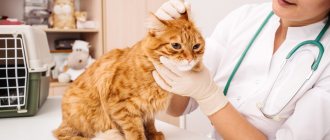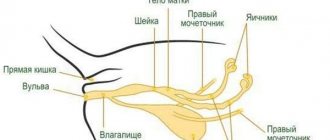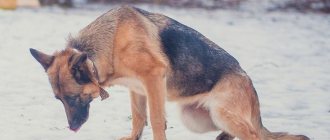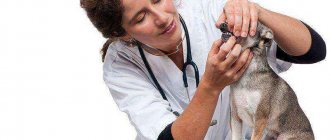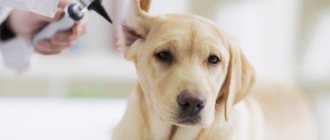If a dog has ear pain, only a veterinarian knows how to treat it after examining and diagnosing the problem. This is due to the fact that an animal is a living being that needs constant attention to care and timely treatment. Therefore, self-medication is not the best option when treating ear problems in pets.
Ear diseases in domestic dogs can be very different and quite often pets may complain of pain inside the ear. Immediately the pain may not appear very sharply, but after a while it intensifies significantly and a certain discharge and unpleasant odor from the ear space may be observed.
If a dog’s ears hurt very often, this can lead to the disease taking its chronic course and, when certain conditions arise, reoccurring again and again. Thus, it is very important to understand that in no case should the disease be left to chance and you should seek advice from a veterinarian as soon as possible in order to help your pet get rid of the pain very quickly.
Ear inflammation in dogs: Symptoms
How can you determine that it is your dog’s ear that hurts and not something else? Examine your pet. Are there any changes in behavior, gait, excessive attention to any part of the body, or active licking?
Look under the tail, feel the stomach and back, examine the oral cavity and ear canals. What should you be wary of, what are the symptoms of ear inflammation-otitis.
First of all, we note that otitis media varies in origin, duration, and location.
The most common is otitis of the external ear, less common when the eardrum is damaged - medial, and even more rare and dangerous - inflammation of the inner ear. Depending on the course, it can be acute or chronic.
Symptoms of otitis media can be either in combination or only one:
- Pain when touching the ear.
- Head shaking.
- Trying to scratch your head or ear.
- Redness of the auricle and external auditory canal.
- Brown discharge from a dog's ear is normal. Exudate of a different color or with a pungent odor may be pathological.
- The dog has a squelching sound in his ear.
- Crusts in the ears.
- Tilt your head to one side.
- Manege movements.
- different pupil sizes.
- Aggression.
- Decreased appetite.
- Lethargy.
Watch the video: Treating Otitis in a dog. How we cured Zlate's ears
Therapeutic complex
Treatment of otitis in dogs at home excludes actions not agreed upon with the veterinarian. Prescription of medications - both local and general - is carried out based on the results of medical diagnosis. Depending on the form and nature of the disease, a four-legged patient may be recommended:
- antibacterial drops for otitis media for dogs (Fugentin, Otipax);
- antifungal drugs (Clotrimazole, Nitrofungin);
- antiparasitic agents (Aurican, Amitrazine);
- anti-inflammatory and antiallergic medications (Sofradex).
Instillation of the ears should be preceded by thorough cleansing. This rule is especially important when treating purulent otitis in a dog. The hygiene procedure requires the owner to know several important things:
- Antiseptics such as boric acid or chlorhexidine will best cope with the removal of sulfur, pus, and crusts;
- Hydrogen peroxide can only be used for external cavities;
- As an aid, it would be preferable not to use ear sticks, but to use special napkins.
To strengthen the strength of the whole body, antibiotic therapy is carried out, sulfonamides are used. New growths are removed on the operating table.
Ear disease in dogs: Causes
What causes dog ears to hurt? Breeds with floppy ears are more susceptible to otitis: Labradors, spaniels, dachshunds, basset dogs and others.
Their auditory canal is less ventilated and there is a more humid environment, which is precisely what pathogenic and conditionally pathogenic microflora need for reproduction.
Reasons for the development of otitis media:
- Parasites . For example, otodectos.
- Allergic reaction. Contact, for example, for ear cleaning lotion. Food allergies, atopy.
- Foreign body. Ingestion of grass, plant seeds, pieces of cotton wool or excessive amounts of fur.
- Primary secretory otitis in dogs of brachycephalic breeds: pugs, French bulldogs.
- Neoplasms.
- Drafts and water getting into the ears can be predisposing factors to otitis media, but are not the root cause.
Description of the pathology
Otitis is an inflammation of different parts of the ear, accompanied by pain, discharge and leading to partial or complete deafness. Most often, two ears are affected at once. The dog's hearing organ is structured somewhat differently than that of humans and is more susceptible to external influences. Dust particles, insects, dirt, and water easily enter the ear canal, which provokes inflammation.
Most often, the disease is diagnosed in lop-eared individuals. Cocker spaniels, dachshunds, and basset hounds are vulnerable. An ideal warm environment for the development of microorganisms is created under the dense earlobe. The disease often occurs in shepherd dogs.
Causes
Pathology is mainly provoked by external factors. Temperature, dust, arthropods influence. But there are also hereditary predisposition, hormonal balance, and nutrition. The table shows the external and internal causes of the disease.
Table - Causes of otitis in Canines
The reasons for the development of pathology can be combined. For example, due to poor nutrition, the dog’s immunity has decreased (lack of vitamins, calcium, iron, magnesium). During a walk, the pet became hypothermic, and the body was unable to resist the development of pathogenic bacteria. The latter, in turn, provoked otitis media.
Classification
Otitis is classified according to three characteristics - localization, development factor, pathogen.
Ear inflammation can affect the outer part of the organ or penetrate deep into the brain. Depending on the location of infection, the disease is divided into three groups.
- Outdoor. Spreads to the outer part of the ear from the ear opening to the eardrum. It is the mildest form of the disease, which does not affect the hearing aid and can be cured with local medications.
- Average . It is most common and affects the area behind the eardrum. May affect the facial nerve. Accompanied by dry conjunctivitis and painful sensations when chewing.
- Internal. Rare, but the most dangerous form. The disease affects the deep structures of the ear. Affects the vestibular apparatus, which is manifested by impaired coordination of movements. May transfer to brain tissue. Without treatment it leads to deafness.
Based on the factor of occurrence, two forms of the disease are distinguished.
- Primary (idiopathic). It arises and develops independently due to the influence of external or internal factors. It can develop in any part of the organ and is classified as external, middle or internal.
- Secondary. It appears as a consequence of advanced skin diseases or pathologies of internal organs. In particular, inflammation is provoked by autoimmune diseases, diseases of the adrenal glands or thyroid gland, atopic dermatitis, and dermatosis.
Depending on the nature of the pathogen, seven types of otitis media are distinguished.
Purulent otitis media develops as a complication of any type of pathology if the pet is not treated in time. It is characterized by copious yellow or greenish discharge with an unpleasant odor. May cause hearing loss.
Symptoms
There are five characteristic symptoms of the pathology.
- Discharge. Thick wax, pus, and blood are released from the auditory organ. In some cases, the eyes fester. The discharge has an unpleasant odor.
- Temperature . The affected ear is noticeably hotter than normal. The animal's overall body temperature may also rise.
- Appearance . The ear turns red and swells. The lymph nodes become denser.
- Combing. The dog feels itchy, often scratches its ear with its paw, leans on its side towards the affected organ and shakes its head.
- Behavior. The pet becomes lethargic and apathetic. Refuses to eat and lies down most of the time. Some individuals whine pitifully or react aggressively to touching their ears.
The sooner full treatment begins, the better for the animal. Therefore, if symptoms are detected, you should not delay contacting a veterinarian.
Consequences
If the disease is not treated in the early stages, it becomes chronic with periodic (seasonal) exacerbations. Also, advanced inflammation leads to the following consequences:
- partial or complete deafness;
- perforation (damage) of the eardrum;
- strabismus;
- meningitis;
- discharge of pus from the eyes.
During periods of exacerbation, the dog experiences pain. It becomes difficult to chew, which leads to digestive problems.
Under no circumstances should otitis media be started. It won't go away on its own. The most dangerous consequence is meningitis (inflammation of the brain). The disease is difficult to treat and often leads to the death of the pet.
Otitis in dogs: Diagnosis
Sometimes owners themselves can determine why their dog’s ear stinks and is inflamed. For example, looking into the ear canal, they see a newly opened tumor or pus.
If the reason is not clear, it is better to consult a doctor. You can start with a therapist, and if necessary, he will refer you to a dermatologist or surgeon.
Diagnostic plan:
- Otoscopy. Inspection of the ear canal up to the eardrum, provided there is no large amount of discharge or swelling.
- Rinse for better visualization.
- Microscopy of the contents of the ear canal to exclude parasitic diseases and assess the cellular composition.
- X-ray of the head with contrast. Assessing the integrity of the eardrum in the absence of other studies.
- Bacterial culture. It is performed if there are rod-shaped bacteria in the ear or with recurrent inflammation.
- Video otoscopy . Study of deep structures, rinsing the ear, removing tumors and removing foreign bodies.
- CT and MRI diagnostics of inflammation of the middle and inner ear.
Watch the video: Ear X-ray and comments - If your dog has ear pain
Diagnostics
If symptoms of otitis are detected, it is important to consult a doctor as soon as possible and have an examination at a veterinary clinic. Specialists can do this in several ways:
- Instrumental method or otoscopy (the method is superficial, but reveals large formations, growths, possibly objects);
- X-ray (a method based on X-rays allows you to determine the nature of formations and growths);
- A complete laboratory examination (blood, urine, smears and skin scrapings are analyzed; allows you to determine the type of pathogen, not only the type of otitis media, but also a specific type of fungus or insect; identifies allergies, including to antibiotics);
- Magnetic resonance or computer tomography (the latest methods that allow you to track the depth of penetration of the disease, possible inflammation of the brain or inner ear canal).
My dog has ear pain: How to treat it at home?
If your pet has ear pain, try to get him help as soon as possible:
- Avoid self-injury. Put on a protective collar; you can make it yourself from scrap materials, for example, from a plastic bottle. Be careful not to injure your dog's neck with sharp edges. The collar will help prevent damage to the ear vessels and the development of otohematoma.
- If there is a large amount of discharge, it is necessary to clean the dog’s ears. How? A special lotion sold at a veterinary pharmacy or pet store is suitable: Otifri , Epiotik, Klini, Rosinka or regular saline solution Sodium chloride 0.9%. There is no need to sanitize frequently; this can lead to even greater inflammation. The ear canal should be filled to the brim, the ear should be squished at the base, the dog should be allowed to shake its ears and the excess lotion and secretions should be removed with a napkin. After 15 minutes, the medicinal drug can be administered.
- For allergic, bacterial, fungal and mixed otitis, you can use drops of Candibiotic (human pharmacy) or Surolan (veterinary). They have a wide spectrum of action, but it is not advisable to use them when the eardrum is perforated. They also will not help in the case of a foreign body, neoplasm, or otitis media and internal otitis.
- For otodectosis, use Inspector, Stronghold or Lawyer drops on the withers or Amit drops in the ears.
It is recommended to consult a veterinarian before using medications.
Do you like the article you are reading now? Look at other materials on this site: What can you give a dog for worms: Doctor's recommendations - Vomiting in a dog without diarrhea and fever: What should the owner do? — Cyst in a dog on the stomach: Causes of formation and methods of treatment — Chronic diarrhea in a dog: Causes, diagnosis, treatment —
Preventive actions
Everyone understands perfectly well that a well-groomed pet is the merit of its owner alone. If the dog's ears and head or other parts of the body begin to go bald, peel or itch, this may be a consequence of frostbite, infection or the presence of parasites. Thus, in order to ensure that the ear never bothers the dog, you must adhere to the following basic rules of proper care:
- When bathing, you must ensure that liquid does not get into the dog’s ears;
- You should not allow your pet to become hypothermic while walking outside in the cold season;
- the dog should not come into contact with sick animals;
- It is necessary to strengthen the dog's immunity.
A timely response to all the alarming symptoms of your pet will help you respond to the problem in a timely manner and eliminate it as effectively as possible.
Ear inflammation in a dog: Treatment
Treatment tactics undoubtedly depend on the underlying cause.
In the event of an allergic reaction, it must be controlled: eliminate the allergen and suppress the symptoms.
To suppress secondary microflora, antifungal, antimicrobial drugs or their combinations in the form of drops are used: Surolan, Isotik, Origin, Posatex and others.
To treat parasitic otitis, drops on the withers and cleaning the ears with lotions are most often used, in the absence of a secondary infection.
Clean your ears as they become dirty, no more than once every few days. Sometimes deep lavage under sedation is required.
For otitis media and internal otitis, drops alone are not enough. Long-term systemic antibiotic therapy, for example, Sinulox . At least three weeks.
Sometimes it is necessary to resort to surgical treatment so that meningitis does not develop, but the animal will lose hearing.
For primary secretory otitis, deep lavage under video-otoscopy control is necessary. An incision has to be made on the eardrum, but it recovers quickly. Secretory otitis may recur.
If tumors are present, surgical excision or chemotherapy is performed.
Signs and symptoms
In most cases, ear diseases have pronounced symptoms. Although the clinical picture depends on the cause of the pathology and the degree of organ damage.
You can guess about ear problems in a dog by the following symptoms:
- hyperemia, swelling of the ears;
- intense ear scratching;
- unpleasant odor;
- possible discharge of exudate;
- constant tilting and shaking of the head;
- painful reaction to touching the ears.
Many ear diseases are accompanied by high fever. This is a sign of an inflammatory process. Any deviations in the animal’s condition are a reason to contact a veterinarian.
Breeds particularly susceptible to otitis media
Breeds with a specific structure of the auricle or with long hair that grows in the ears are prone to the appearance and development of otitis.
Thick guard hairs obscure the canal, interfere with natural ventilation, and promote the accumulation of sulfur and the proliferation of bacteria in it. The risk group includes all pets with long hair: Lapdogs, Pekingese, Yorkshire terriers, Setters, long-haired Toy terriers, etc.
Similar problems arise in animals with long floppy ears: Spaniels, Setters, Bassets, Poodles. In addition, the self-cleaning mechanisms are hampered by the abundant skin folds around the ears of Bulldogs, various breeds of Mastiffs, and Shar-Peis.
A separate group predisposed to the disease are dogs with long erect ears: German Shepherds, Corgis, Staffies, Giant Schnauzers. They turn their ears to the wind, thereby catching drafts and chilling the hearing organs.
Any breed can be affected by the disease. It is important to monitor the hygiene of the ear cavities, checking it for dirt, strange discharge and stuck objects.
How dangerous is the disease?
In general, with timely and competent treatment, otitis media will not be a dangerous disease. However, in the opposite case, inflammation develops into chronic inflammation and attracts unpleasant problems. The first terrible complication is hearing loss (complete or partial).
Treatment methods
Treatment should be prescribed only by a doctor, based on the diagnostic results and the nature of the pathology. If a foreign object gets into your dog's ear or a large amount of wax has accumulated, you cannot remove it yourself. There is a high risk of eardrum damage. A doctor should do this and, if necessary, tell you how to further care for your ears.
Treatment of otitis media
The causative agents of otitis media can be bacteria, fungi, and viruses. Therefore, treatment tactics will entirely depend on the cause. If laboratory tests reveal bacterial microflora, antibiotics are prescribed. In uncomplicated cases, you can limit yourself to local remedies. The resulting crusts are carefully removed using a cotton swab moistened with hydrogen peroxide. Then the surface of the ear is treated with Chlorhexidine or Miramistin. Twice a day, drops of Sofradex or Surolan can be instilled inside and Bepanten Ointment applied. For oral administration, it is recommended to give the dog anti-inflammatory tablets (Liarsin, Serrata).
Help with otodectosis
If ear mites are present, acaricidal agents are used effectively. The dog's ears must first be cleaned with Furacilin solution. This must be done carefully so as not to damage the eardrum.
Acaricides can be in the form of drops, ointments, or aerosols. The most effective:
- Surolan;
- Leopard;
- Stronghold;
- Odin.
As a rule, these drugs are effective against adults. Therefore, ear treatment must be repeated after 1-1.5 weeks. Acaricides must be warmed to room temperature before application. Treat the inner surface of the ear, gently massage along the longitudinal axis so that the medicine is evenly distributed.
Dried crusts from the ears should be cleaned daily.
Getting rid of fleas
You can get rid of fleas using insecticides (Frontline, Stronghold). They are selected taking into account the age, weight of the dog, and the degree of flea infestation.
Action algorithm:
- Bathe your dog with a special shampoo.
- Comb the coat with a fine-toothed comb.
- Apply the insecticide prescribed by your doctor.
- After 3-4 weeks, repeat the treatment.
Fleas, their eggs and larvae can be found on household items and bedding. Therefore, it is imperative to regularly thoroughly clean the premises and disinfect things that the pet comes into contact with. Fleas often become carriers of helminths. Therefore, for prevention, it is recommended to remove worms from the dog using special anthelmintic drugs.
